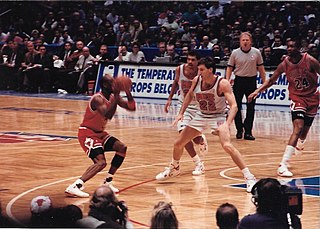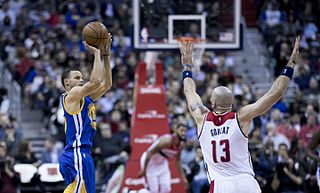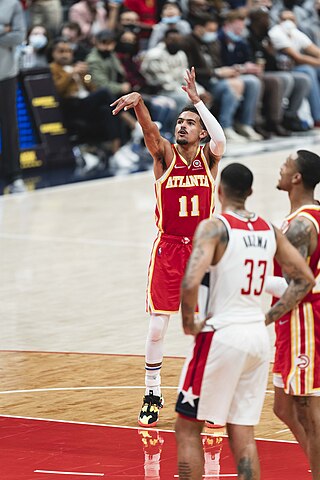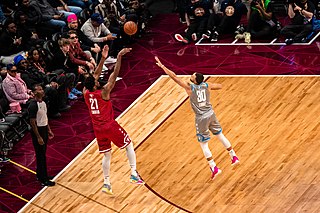
Basketball is a team sport in which two teams, most commonly of five players each, opposing one another on a rectangular court, compete with the primary objective of shooting a basketball through the defender's hoop, while preventing the opposing team from shooting through their own hoop. A field goal is worth two points, unless made from behind the three-point line, when it is worth three. After a foul, timed play stops and the player fouled or designated to shoot a technical foul is given one, two or three one-point free throws. The team with the most points at the end of the game wins, but if regulation play expires with the score tied, an additional period of play (overtime) is mandated.
Alan Albert is a sportscaster, who formerly called basketball games for the New York Nets and Denver Nuggets, national NBA and NHL coverage for the USA Network. He was also a play-by-play sportscaster for the Indiana Pacers. He has also worked in boxing, as the blow-by-blow announcer for Tuesday Night Fights.

In basketball, the basketball court is the playing surface, consisting of a rectangular floor, with baskets at each end. Indoor basketball courts are almost always made of polished wood, usually maple, with 3.048 meters (10 ft)-high rims on each basket. Outdoor surfaces are generally made from standard paving materials such as concrete or asphalt. International competitions may use glass basketball courts.

In basketball, a player may attempt to score a basket by leaping straight into the air, the elbow of the shooting hand cocked, ball in hand above the head, and launching the ball in a high arc towards the basket for a jump shot. Although early critics thought the leap might lead to indecision in the air, the jump shot replaced the earlier, less quickly released set shot, and eventually transformed the game because it is the easiest shot to make from a distance and more difficult for a defender to block. Variations on the simple jump shot include the "turnaround jumper" ; the "fadeaway" ; and the "leaning jumper". With the "hook shot," a player is turned sideways with the shooting arm away from the basket outstretched so that with a sweep he can launch the ball over his head. Since a defender must leap to block a jumper, the shooter may use a pump fake to get the defender in the air at the wrong time and so have a clear shot. If the shooter leaps into the defender, a foul is called on the defensive player, whereas the shooter is awarded two or three free throws according to the value of a missed attempt, or a single free throw.

In basketball, free throws or foul shots are unopposed attempts to score points by shooting from behind the free-throw line, a line situated at the end of the restricted area. Free throws are generally awarded after a foul on the shooter by the opposing team, analogous to penalty shots in other team sports. Free throws are also awarded in other situations, including technical fouls, and when the fouling team has entered the bonus/penalty situation. Also, depending on the situation, a player may be awarded between one and three free throws. Each successful free throw is worth one point.

Streetball is a variation of basketball, typically played on outdoor courts and featuring significantly less formal structure and enforcement of the game's rules. As such, its format is more conducive to allowing players to publicly showcase their own individual skills. Streetball may also refer to other urban sports played on asphalt. It is particularly popular and important in New York City and Los Angeles, though its popularity has spread across the United States due to the game's adaptability.
Twenty-one, also called play21basketball, cutthroat, hustle, tip-it, noyceball, roughhouse, scutter,rough, or rebound is a popular variation of street basketball. The game is played with any number of players on a half court, but typically when not enough players are available to at least play three-on-three. Twenty-one is an individual game that does not utilize team play.

In basketball, a block or blocked shot occurs when a defensive player legally deflects a field goal attempt from an offensive player to prevent a score. The defender is not allowed to make contact with the offensive player's hand or a foul is called. In order to be legal, the block must occur while the shot is traveling upward or at its apex. A deflected field goal that is made does not count as a blocked shot and simply counts as a successful field goal attempt for shooter plus the points awarded to the shooting team. For the shooter, a blocked shot is counted as a missed field goal attempt. Also, on a shooting foul, a blocked shot cannot be awarded or counted, even if the player who deflected the field goal attempt is different from the player who committed the foul. If the ball is heading downward when the defender hits it, it is ruled as goaltending and counts as a made basket. Goaltending is also called if the block is made after the ball bounces on the backboard.

In basketball, there are five players on court per team, each assigned to positions. Historically, these players have been assigned to positions defined by the role they play on the court, from a strategic point of view. The three main positions are guard, forward, and center, with the standard team featuring two guards, two forwards, and a center. Over time, as more specialized roles developed, each of the guards and forwards came to be differentiated, and today each of the five positions is known by a unique name and number: point guard (PG) or 1, the shooting guard (SG) or 2, the small forward (SF) or 3, the power forward (PF) or 4, and the center (C) or 5 "post position".

A three-point field goal is a field goal in a basketball game made from beyond the three-point line, a designated arc surrounding the basket. A successful attempt is worth three points, in contrast to the two points awarded for field goals made within the three-point line and the one point for each made free throw.

The 2000 NBA Finals was the championship round of the National Basketball Association (NBA)'s 1999–2000 season, and the conclusion of the season's playoffs. The Western Conference champion Los Angeles Lakers defeated the Eastern Conference champion Indiana Pacers 4 games to 2. The series was played under a best-of-seven format, with the Lakers holding home court advantage. The series featured the number one seeds from both conferences. Lakers center Shaquille O'Neal was named the NBA Finals Most Valuable Player (MVP) of the series, his first of three consecutive honors, in arguably one of the best NBA Finals performances in history putting up 38.0 points, 16.7 rebounds and 2.7 blocks per game.

This glossary of basketball terms is a list of definitions of terms used in the game of basketball. Like any other major sport, basketball features its own extensive vocabulary of unique words and phrases used by players, coaches, sports journalists, commentators, and fans.
A half-court short is a shot taken from beyond the 3-pointer line as defined by a semicircular line before the 2-pointer zone. Anything beyond the half-court line and on the side of the court a team or player is defending is considered a full-court shot. It is most commonly used as a buzzer beater as there is a limited amount of time before a turnover. It is also used as a streetball term where the teams only use half of the full court. The most common backcourt shot style is known as "the Runner". If the shooter has a few seconds to spare, "the Runner" can be used to shorten the distance to the rim while also adding extra power to the shot. Other backcourt shot styles include: "the Sheed" ; "the Contested Prayer"; and "the Zoran". Since an NBA game court is 94 feet (29 m) long, the midcourt line is 47 feet (14 m) away from each baseline.
Variations of basketball are games or activities based on, or similar in origin to, the game of basketball, in which the player utilizes common basketball skills. Some are essentially identical to basketball, with only minor rules changes, while others are more distant and arguably not simple variations but distinct games. Other variations include children's games, contests or activities intended to help the player practice or reinforce skills, which may or may not have a competitive aspect. Most of the variations are played in informal settings, without the presence of referees or other officials and sometimes without strict adherence to official game rules.

The 1993 NBA Playoffs was the postseason tournament of the National Basketball Association's 1992–93 season. The tournament concluded with the Eastern Conference champion Chicago Bulls defeating the Western Conference champion Phoenix Suns 4 games to 2 in the NBA Finals. Michael Jordan was named NBA Finals MVP for the third straight year. This was the Suns' second Western Conference title; they made their first NBA Finals appearance since 1976, losing to the Boston Celtics.

In basketball, a field goal is a basket scored on any shot or tap other than a free throw, worth two or three points depending on the location of the attempt on the basket. Uncommonly, a field goal can be worth other values such as one point in FIBA 3x3 basketball competitions or four points in the BIG3 basketball league. "Field goal" is the official terminology used by the National Basketball Association (NBA) in their rule book, in their box scores and statistics, and in referees' rulings. The same term is also the official wording used by the National Collegiate Athletic Association (NCAA) and high school basketball.
Cherry picking, in basketball and certain other sports, refers to play where one player does not play defense with the rest of the team, but rather remains near half court or closer to their own team's goal.

3x3 basketball is a variation of basketball played three-a-side, with one backboard and in a half-court setup. According to an ESSEC Business School study commissioned by the International Olympic Committee, 3x3 is the largest urban team sport in the world. This basketball game format is currently being promoted and structured by FIBA, the sport's governing body. Its primary competition is an annual FIBA 3X3 World Tour, comprising a series of Masters and one Final tournament, and awarding six-figure prize money in US dollars. The FIBA 3x3 World Cups for men and women are the highest tournaments for national 3x3 teams. The 3x3 format has been adopted for both the 2020 Summer Olympics and 2022 Commonwealth Games.

Thunderstruck is a 2012 American sports comedy film directed by John Whitesell and starring professional NBA player Kevin Durant and Taylor Gray as well as Brandon T. Jackson, Doc Shaw and Jim Belushi. The plot follows a boy who magically gets Durant's basketball skills and the duo must figure out how to return them. It was released on August 24, 2012.
College Basketball on USA is the de facto title for the USA Network's coverage of NCAA men's basketball. During the 1980s, USA's telecasts were produced in association with Mizlou TV Sports.













